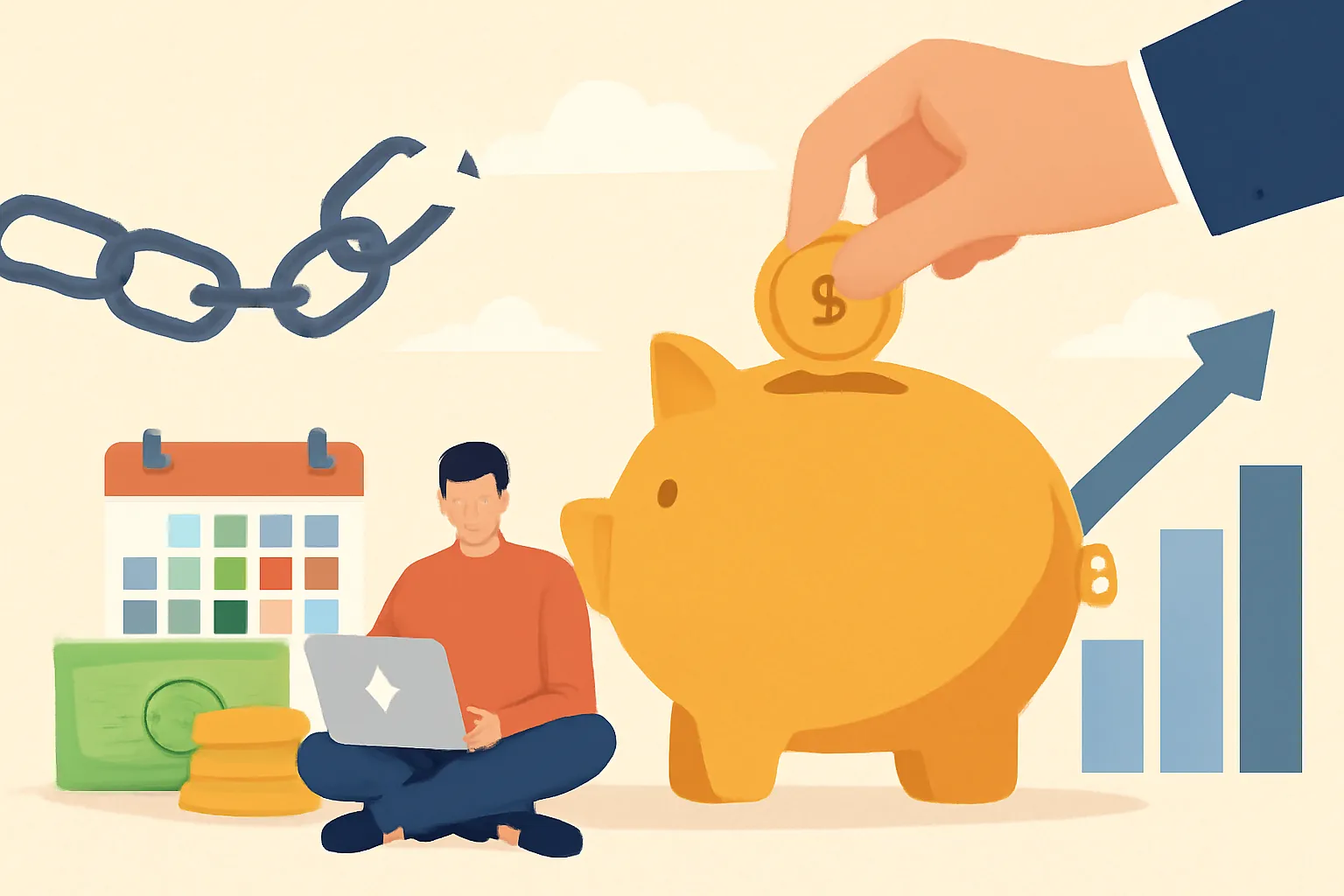Understanding the Paycheck to Paycheck Cycle
Millions of people around the world struggle with the constant stress of living paycheck to paycheck. This cycle can feel never-ending, leaving you anxious about bills, unable to save, and worried about any unexpected expense. If you’re tired of feeling like you’re just treading water financially, you’re not alone—and you’re not powerless. By learning how to break the paycheck to paycheck cycle, you can start your journey toward financial freedom.
But what does it mean to live paycheck to paycheck? Essentially, it means that all or most of your income goes toward immediate expenses, leaving little to nothing left over by the time your next payday arrives. This situation can be caused by many factors: high living costs, low income, poor spending habits, debt, or a lack of financial literacy.
Why Breaking the Cycle is Crucial
The negative effects of this cycle extend far beyond financial stress. Constantly worrying about money can harm your health, relationships, and overall quality of life. Financial security isn’t just about numbers—it’s about peace of mind, opportunity, and the freedom to make choices without fear. By taking action to stop living paycheck to paycheck, you are investing in your future happiness and well-being.
Assessing Your Current Financial Situation
The first step in escaping the paycheck-to-paycheck lifestyle is understanding your current financial situation. You can’t fix what you can’t see. Start by gathering information about your income, expenses, debts, and assets.
Track Your Income and Expenses
- List all sources of income: Include your salary, side hustles, government benefits, or any passive income.
- Track every expense: For at least a month, write down every purchase, bill, and payment. Use a notebook, spreadsheet, or budgeting app.
- Identify patterns: Are there areas where you consistently overspend? Are there subscriptions or services you no longer use?
Many people are surprised to find out how much they spend on seemingly minor things, like takeout coffee, streaming services, or dining out. These small expenses can add up quickly, making it harder to break free from the cycle.
Creating a Realistic Budget
Once you know where your money is going, it’s time to create a budget. A budget is simply a plan for how you’ll spend and save your money each month. It helps you make intentional decisions and avoid financial surprises.
Steps to Build a Budget
- List your net income (after taxes and deductions).
- Write down your fixed expenses (rent, mortgage, car payment, insurance, utilities).
- Add your variable expenses (groceries, gas, entertainment, clothing).
- Set spending limits for each category based on your priorities.
- Include savings as a non-negotiable expense.
Remember, a budget isn’t about restricting yourself—it’s about giving you control over your money. Revisit and adjust your budget every month to reflect changes in your income or expenses.
Cutting Unnecessary Expenses
To stop living paycheck to paycheck, you may need to cut back on non-essential spending. This doesn’t mean depriving yourself of all fun or enjoyment. Instead, focus on eliminating expenses that don’t bring you real value or happiness.
Common Areas to Reduce Spending
- Dining out: Cook at home more often and limit restaurant meals.
- Subscription services: Cancel unused or rarely used subscriptions.
- Impulse purchases: Wait 24 hours before buying non-essential items.
- Brand-name products: Choose generic alternatives where possible.
- Utility bills: Reduce energy use, shop for better rates, or negotiate with providers.
Every dollar you save can be redirected toward your financial goals, whether that’s building an emergency fund, paying down debt, or investing for the future.
Increasing Your Income
While cutting expenses is crucial, sometimes the real problem is simply not earning enough. If your budget is already tight and you’re still struggling, it’s time to look for ways to increase your income.
Ideas to Boost Your Earnings
- Ask for a raise at your current job if you’ve taken on more responsibility or exceeded expectations.
- Look for a higher-paying job or explore new career opportunities.
- Start a side hustle such as freelancing, tutoring, pet-sitting, or rideshare driving.
- Sell unused items online or at a garage sale.
- Monetize a hobby like crafting, baking, or photography.
Even a modest increase in income can make a significant difference over time, helping you break the cycle of living paycheck to paycheck.
Building an Emergency Fund
One of the main reasons people remain stuck in the paycheck-to-paycheck lifestyle is a lack of savings. Without a financial cushion, any unexpected expense—a car repair, medical bill, or job loss—can throw your entire budget into chaos.
How to Start an Emergency Fund
- Set a realistic goal: Aim for at least $500 to $1,000 to start, then gradually build up to three to six months’ worth of living expenses.
- Open a separate savings account to avoid the temptation to spend your emergency money.
- Automate your savings: Set up automatic transfers from your checking account to your emergency fund.
- Use windfalls: Direct tax refunds, bonuses, or gifts toward your savings goal.
Having an emergency fund gives you peace of mind and protects you from falling back into the paycheck-to-paycheck trap when life throws you a curveball.
Paying Off Debt Strategically
Debt can be a major obstacle to achieving financial freedom. High-interest debt, especially from credit cards, can eat up a large portion of your income and keep you stuck in a cycle of minimum payments. To stop living paycheck to paycheck, make a plan to pay off your debt as efficiently as possible.
Effective Debt Repayment Methods
- Debt Snowball: Pay off your smallest debts first, then roll those payments into your next smallest debt. This method builds momentum and motivation.
- Debt Avalanche: Focus on paying off debts with the highest interest rates first, saving you the most money in the long run.
- Debt consolidation: Consider consolidating multiple debts into a single payment with a lower interest rate.
- Negotiate with creditors: Sometimes, you can lower your interest rates or set up payment plans.
Whichever method you choose, make consistent payments and avoid taking on new debt. Every dollar you pay down is a step closer to financial independence.
Automating Your Finances
One of the best ways to ensure you stick to your financial plan is to automate your finances. Automation removes the temptation to skip savings or miss bill payments.
Ways to Automate Your Money
- Direct deposit: Have your paycheck deposited directly into your checking account.
- Automatic bill pay: Set up recurring payments for rent, utilities, loans, and credit cards.
- Automated savings: Schedule regular transfers to your emergency fund or investment accounts.
- Invest automatically: Use robo-advisors or employer-sponsored retirement plans to invest regularly without thinking about it.
Automation helps you stay on track and ensures your financial priorities are met before you have a chance to spend impulsively.
Improving Financial Literacy
Knowledge is power. The more you understand about personal finance, the better equipped you’ll be to escape the paycheck to paycheck lifestyle. Fortunately, there are countless resources available today.
Ways to Increase Your Financial Knowledge
- Read personal finance books and blogs.
- Listen to podcasts focused on budgeting, investing, and debt repayment.
- Take online courses (many are free) on platforms like Coursera, Udemy, or Khan Academy.
- Attend financial workshops in your community.
- Consult with a financial advisor if you need personalized guidance.
The more you learn, the more confident you’ll feel in making smart financial decisions that move you closer to financial independence.
Setting Long-Term Financial Goals
Breaking the paycheck-to-paycheck cycle is just the beginning. To truly achieve financial freedom, you need to set clear, motivating goals for your future.
Examples of Financial Goals
- Save for a home down payment
- Build a retirement nest egg
- Travel or pursue hobbies without financial worry
- Start your own business
- Provide for your family’s education or health needs
Write down your goals, break them into manageable steps, and celebrate your progress along the way. Having a clear vision will keep you motivated and focused, even when the journey gets tough.
Building Better Money Habits
The key to escaping the paycheck to paycheck trap is consistency. It’s not about making one big change, but rather developing small, positive habits that add up over time.
Habits for Financial Success
- Review your budget regularly and adjust as needed.
- Track your spending to spot trends and stay accountable.
- Plan your purchases instead of shopping impulsively.
- Save a percentage of every paycheck, no matter how small.
- Check your credit report annually to correct errors and monitor your progress.
Over time, these habits become second nature, helping you maintain your progress and continue moving toward financial freedom.
Dealing with Setbacks and Staying Motivated
No journey is without setbacks. You may face unexpected expenses, job changes, or periods where it feels like you’re not making progress. The important thing is to stay committed and remember why you started.
How to Bounce Back
- Don’t be too hard on yourself—setbacks are a normal part of the process.
- Review your goals and remind yourself of your “why.”
- Adjust your budget or repayment plan if your circumstances change.
- Reach out for support from friends, family, or online communities.
- Celebrate small victories to stay motivated.
Persistence is key. Every step you take brings you closer to breaking the paycheck-to-paycheck cycle for good.
Teaching Your Family Good Money Practices
If you have a family, it’s important to involve them in your financial journey. Teaching children about money and setting a good example can help ensure that the cycle of living paycheck to paycheck doesn’t continue into the next generation.
Ways to Involve Your Family
- Discuss the family budget openly and honestly.
- Set shared financial goals and celebrate achievements together.
- Give children age-appropriate chores and teach them to save their earnings.
- Encourage open conversations about money—both successes and mistakes.
- Lead by example with smart financial decisions.
Building a strong financial foundation as a family can provide security and opportunity for everyone.
When to Seek Professional Help
Sometimes, breaking the cycle of living paycheck to paycheck requires more than self-help. If you’re overwhelmed by debt, facing legal action, or simply don’t know where to start, consider reaching out to a professional.
Who Can Help?
- Certified financial planners can help you create a personalized plan.
- Credit counselors offer guidance on managing debt and improving credit.
- Non-profit organizations provide free or low-cost financial education and support.
- Accountants or tax professionals can help optimize your finances and ensure compliance.
There is no shame in seeking help. In fact, reaching out is a sign of strength and commitment to your financial future.
Conclusion: Your Path to Financial Freedom
Breaking free from the cycle of living paycheck to paycheck is not easy, but it is possible. By understanding your finances, creating a realistic budget, cutting unnecessary expenses, increasing your income, building an emergency fund, paying off debt, and developing better money habits, you can reclaim control over your financial life.
Remember, the journey to financial freedom is a marathon, not a sprint. Start with small, manageable steps and build on your progress. Stay motivated by keeping your goals in sight and celebrating your achievements along the way. You have the power to stop living paycheck to paycheck and create the secure, fulfilling future you deserve.
Take the first step today—your financial freedom awaits.

